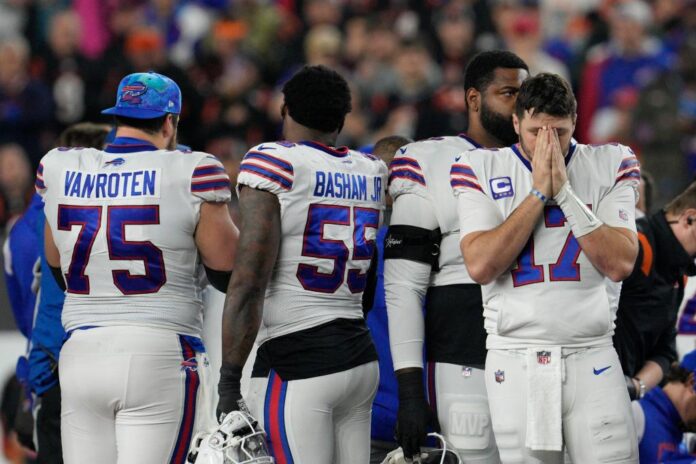They play knowing the potential consequences. They play understanding that at any moment your knee can go one way, the rest of you the other. They play despite the blood, despite the pain, despite the knowledge that the worst injury of all might not surface until 40 years after their final snap, on a brain scan.
“We play,” Vinny Testaverde said one day in the summer of 2000, as he was attempting to come back from a blown-out Achilles, “because there is no greater high than playing at this level. But every one of us knows how fragile it all is. And just about every one of us has learned that lesson firsthand, the hard way.”
But none of them ever believes it will come to this, collapsing to the turf of a sold-out stadium on national television. They are young men, all of them, in extraordinary shape. Ankles snap. Spinal cords are ruined. Shoulders tear.
But collapsing?
That is one they never see coming. That is certainly not something a 24-year-old Buffalo Bills safety named Damar Hamlin was even pondering as he prepared to play the most important game of the season, at Cincinnati’s Paycor Stadium.
Hamlin was in on a play. He got to his feet. And then he fell. At first it looked like any of a dozen terrifying moments in any NFL game, a player felled by the viciousness of the game. But soon it was obvious: this was something different. This was something worse. Players on both teams frantically called for help from the sidelines. Players ringed around Hamlin so TV cameras — thankfully — couldn’t capture the site of CPR being administered.
It was chilling. It was jarring.


Back on Oct. 23, 1971, a reserve receiver for the Detroit Lions named Chuck Hughes caught a pass late in a game against the Bears and was tackled by two Chicago players. A few plays later he served as a decoy on a play, locked eyes with Chicago’s Dick Butkus on his way back to the huddle, and a few seconds later his eyes rolled back in his head and he collapsed to the grass at Tiger Stadium. He was carried off on a stretcher. He was given emergency care in the tunnel, rushed to the hospital where he was declared dead of cardiac arrest at 5:41 p.m.
The Bears and Lions played on.
Fifty-one years later, it actually seemed that the Bengals and Bills would resume the game after a five-minute “suspension” as Hamlin was loaded onto an ambulance and taken to University of Cincinnati Medical Center. The NFL is fortunate that the Bills are coached by Sean McDermott and the Bengals are coached by Zac Taylor, who understood a very simple truth:
Their players couldn’t play a football game after witnessing that.
They are human beings. Many of their faces — both teams — were streaked with tears. Five minutes? That wasn’t going to work. McDermott waved his players off the field. So did Taylor. Sometimes it is best to allow the men who play this game to figure out what is right. Usually they do.
Back in September 2001, it took Michael Strahan of the Giants and Kevin Mawae of the Jets to vow in no uncertain terms that the two New York teams would not be playing football on Sunday, Sept. 17, not while Ground Zero was still smoldering in lower Manhattan. That forced the NFL to do the right thing. Pete Rozelle could have used such wise counsel; he went to his grave regretting that he didn’t cancel that games of Nov. 24, 1963, two days after President John F. Kennedy was assassinated.


Strahan and Mawae carried the day in 2001. McDermott, Taylor and their players did so Monday night. The teams retreated to their locker rooms. About an hour later the NFL announced the game was officially postponed — while also announcing Hamlin was listed in critical condition.
It is a hard game, a mean game, a vicious game. The players know it. The coaches know it. The fans know it. We receive periodic bursts of sobering truth — gruesome leg injuries like the ones suffered by Joe Theismann and Tim Krumrie, horrifying spine injuries like the ones we watched Dennis Byrd and Darryl Stingley and Mike Utley.
And then we get something like Monday night, Damar Hamlin on his feet one moment and on the ground the next, and we are reminded of the true consequences plasters face every week, every game, every snap. And that these players really are flesh and blood, really are human beings. They hurt — and hurt for their teammates.
Thankfully, as often as not, they’re also the ones who know how to properly respond when tragedy visits the field.
Credit: Source link

















